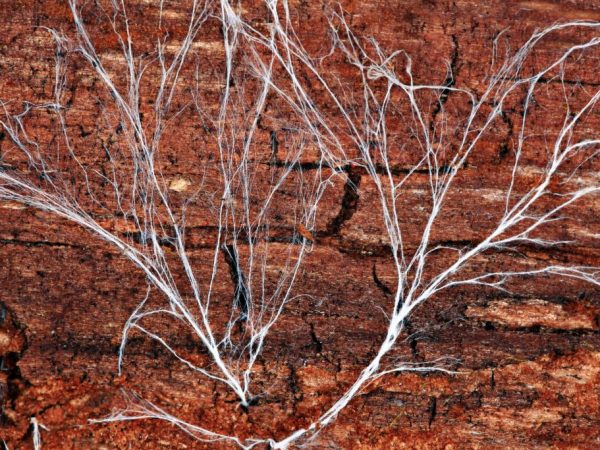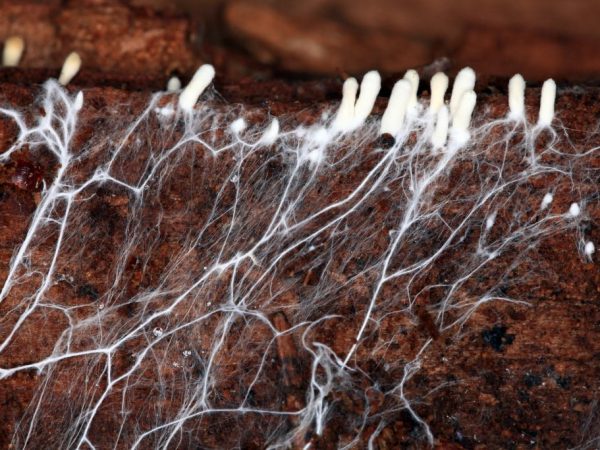What are mushroom hyphae
Fungus hyphae are thin threads of which the fungus organism consists. Mycelium hyphae are located underground. These processes provide the body with communication with the external environment.

Mushroom hyphae
general characteristics
In mushrooms there is a combination of animal and plant characteristics. The following traits are related to the plant world:
- the cell wall is expressively presented;
- attached way of life;
- unlimited growth;
- reproduce by spores;
- can synthesize vitamins;
- the presence of vacuoles;
- an absorbent way of eating.
The following signs are similar to animals:
- the presence of chitin;
- absence of all types of plastids, including photosynthetic ones;
- heterotrophy;
- accumulate glycogen;
- the metabolic product is urea.
Due to this specific structure and functioning, they are ranked among the oldest species of eukaryotes. But they have no evolutionary connection with plants. Today, more than 100,000 species of these representatives of the living nature of our planet have been studied. True, scientists believe that the real figure is much higher and can reach 250,000 or even 1.5 million.
Mushroom structure
The cap and leg are the fruiting body. And the "working" part - mycelium or mycelium - is located inside wood, soil or substrate. The fruiting body does not live long, about 10-15 days. The fungus can even live for hundreds of years. It is resistant to low temperatures and drought.
Under unfavorable conditions, the mycelium stops its development. Under suitable conditions, the mycelium "wakes up" and continues to grow, but the fruiting bodies may not form. The mycelium consists of thin intertwining threads - hyphae.
What are GIFs
The fungal hyphae is a typical morphological structural unit of this organism.
It is a tube in the form of a cylinder (5 to 10 microns in diameter). There are species in which hyphae grow up to 170 microns. Inside the shell of thin filaments there is a multinucleated plasma, it forms new cells at the tip.
Irina Selyutina (Biologist):
Hyphae are able to combine into:
- rhizomorphs: more or less loose strands (several meters long and several millimeters thick);
- sclerotia: dense plexuses from which fruiting organs are formed.
The entire set of fungal hyphae makes up the mycelium (mycelium). That part of it, which is located in the soil and, accordingly, is hidden from human eyes is called the "vegetative body". The part located above the soil surface and intended for sporulation is called the "fruiting body" in cap mushrooms. Groups of hyphae, which are tightly intertwined in the fruiting bodies, form plectenchyma or false tissue, or pseudoparenchyma. In appearance, plectenchyme resembles the main plant tissue - the parenchyma, however, it is formed not by three-dimensional dividing cells, but simply by contiguous hyphae. The layer of hyphae covering the cap contains pigments that give it a specific color.
The myceliums constantly grow in length, at the end of the filament they begin to branch out, and the protoplasm continuously moves to the young part of the filament. Aged areas can be separated by a wall, which appears due to the ingrowth of the hyphae membrane.
Views

Hyphae absorb nutrients
Mushroom hyphae are colorless. Sometimes the processes become yellowish or brown in color.
Depending on the presence of partitions, the threads can be divided into groups:
- Aseptated: hyphae without diametrical walls, i.e. non-cellular. Inherent in lower mushrooms.
- Septic: have partitions (in the center of which holes are preserved), which create individual cells, therefore they are also called multicellular. All higher ones: caps, some molds and others have this type of hyphae.
Functions
The hyphae of the fungus have the main task of absorbing, transferring nutrients and reproduction.
Food
The absorption of water and food is the main function of the hyphae.
There are threads that are modified in a haustorium, trapping loops, and more. By the nature of their nutrition, all mushrooms are heterotrophs, however, by the type of nutrition they are divided into:
- Saprotrophs: most of the mold, cap fungi and yeast. The specificity is that the body is able to create a mycelium from hyphae more than a kilometer long. Thanks to this, the body communicates closely with the external environment.
- Parasites: feed on other living organisms.
- Symbionts (symbiotrophs): enter into mutually beneficial relationships with representatives of other types of living organisms, forming mycorrhiza.
- Predatory mushrooms: are capable of eating some animal organisms, but they are able to live like saprotrophs.
Irina Selyutina (Biologist):
At the moment, most mycologists are inclined to believe that the saprotrophic type of nutrition of fungi is primary, but parasitism is secondary, which arose in the process of evolution as a result of adaptation to life in new, often unfavorable conditions with competition for habitats. Now more than 10,000 species of parasitic fungi are known that can live on a variety of plants and animals, other fungi and lichens. Therefore, they are very diverse both in lifestyle and in nutrition. Some species are narrowly adapted and feed on only one species of the host organism. Others, on the contrary, are able to use for their own purposes a number of host species belonging not only to different families, but even to other kingdoms of living nature.
Almost every cell of the mycelium is separated from the environment by a thin cell wall. Digestive enzymes affect the nutrient medium and aid in its digestion outside the cell. Further, the product prepared in this way is absorbed by the entire cell.
Reproduction
Mushrooms can reproduce in three ways:
- Asexual: reproduction takes place through endo- and exogenous spores. Endogenous are formed inside the sporangia. And exogenous spores develop on the processes of the mycelium - conidiophores. When the spore is in a suitable environment, it wakes up, grows and mycelium appears.
- Sexual: this type of reproduction is characterized by its diversity. Certain types of organisms multiply by combining the insides of two cells located at the tips of the hyphae.
- Vegetative: carried out in several ways:
- when separating from the bulk of the mycelium of its parts, capable of independent development;
- arthrospores (oidia), which are formed when hyphae disintegrates into separate short cells, each of which gives rise to a new organism;
- chlamydospores: they have a thick dark-colored shell, are able to withstand adverse conditions, then germinating most often with mycelium;
- budding: whole mycelium or individual cells.
Conclusion
Mushroom hyphae grow at different rates. It depends on the nutrient medium, the characteristics of the organism, external factors and much more. The growth rate of the fungal colony depends on the growth rate.
Sometimes the mushroom hyphae change. Some change their appearance due to adaptation to the performance of certain functions. So, there is a mushroom, which consists of hyphae in the shape of an arc. Thanks to them, the body expands the boundaries of its population.And in a large number of parasitic fungi, apressoria is formed. They can attach the mushroom to different surfaces. Hyphae also enter into relationships with higher plants or algae.


